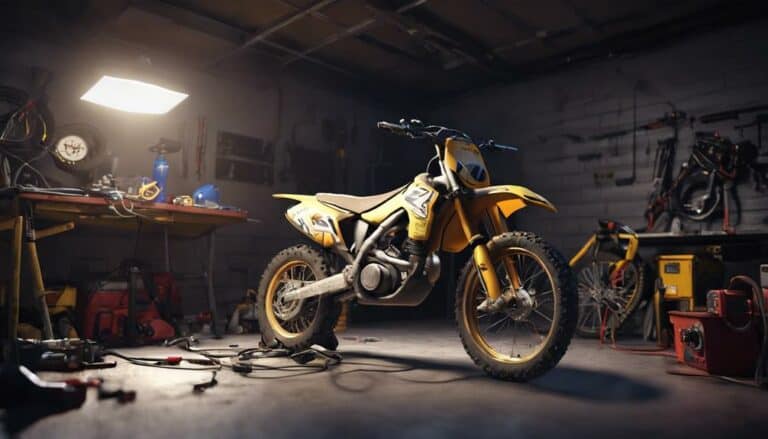When testing the dirt bike's lighting system, start with a visual check for damage or wear on bulbs and wiring. Confirm tight connections and clean lenses. Then, validate current flow through continuity testing with a multimeter. Conduct voltage testing to check the power levels within the required range. Evaluate electric charge flow using a clamp meter for current testing. To conclude, perform resistance testing to identify potential barriers to current flow. These methods will help you guarantee the lighting system functions at its best and securely for your dirt bike rides.
Key Takeaways
- Visual inspection for damage, wear, and connectivity.
- Conduct continuity testing with a multimeter.
- Perform voltage testing to check electrical potential.
- Use a clamp meter for current flow assessment.
- Resistance testing to identify barriers to current flow.
Visual Inspection
Perform a thorough visual inspection of your dirt bike's lighting components to assess their condition and functionality before conducting further tests. Start by checking the bulbs for any signs of damage or wear. Look closely at the wiring to confirm there are no exposed wires, fraying, or signs of deterioration. Inspect the connectors for corrosion or loose connections that could affect the electrical flow to the lights.
During the visual inspection, pay close attention to any burnt-out bulbs that may need replacement. Make sure to clean the lenses of the headlights, taillights, and turn signals to maintain peak light output. Check the mounting hardware and brackets to confirm that the lights are securely attached to the bike and properly aligned for maximum visibility on the road.
This meticulous examination of the lighting system is essential to identifying any potential issues that could impact its performance. By addressing any visible damage or wear during the visual inspection, you can guarantee that your dirt bike's lighting components are in top condition before moving on to more detailed testing methods.
Continuity Testing
After conducting a thorough visual inspection of your dirt bike's lighting components, the next step is to conduct continuity testing to verify the uninterrupted flow of current in the wiring and connections.
Continuity testing is essential as it helps pinpoint breaks or faults in the electrical paths that could lead to lighting malfunctions. To perform this test, use a multimeter set to the continuity mode. With the multimeter probes, test each wire and connection to guarantee a complete circuit.
When the multimeter beeps or shows continuity, it indicates a solid connection, while the absence of a beep suggests a break in the circuit. This method is vital for ensuring the proper functioning of your dirt bike's lighting system and efficiently troubleshooting any issues that may arise.
Voltage Testing
To assess the electrical potential difference in your dirt bike's lighting system accurately, begin by conducting voltage testing using a multimeter set to the appropriate range. Voltage testing plays an important role in guaranteeing that the lighting circuit receives the correct amount of power for ideal functionality.
By measuring the voltage levels, you can determine if the system operates within the specified range, which is essential for proper performance. This testing method helps identify issues like overvoltage or undervoltage that could impact the brightness and overall operation of the lights.
Regular voltage testing is recommended to maintain the efficiency and effectiveness of your dirt bike's lighting system. By incorporating this testing into your maintenance routine, you can catch potential problems early and make sure that your lights function as intended, enhancing your overall riding experience.
Current Testing
Wondering how to precisely assess the flow of electric charge in your dirt bike's lighting system? Current testing is the key to understanding the health of your charging system and ensuring your lights operate at their best.
Here's how you can effectively perform current testing using a clamp meter:
- Select the Right Setting: Set your clamp meter to measure the current range expected in the lighting system.
- Identify the Circuit: Locate the wiring or component where you want to measure the current flow.
- Clamp the Meter: Place the clamp around the wire to measure the current passing through it.
- Read the Measurement: Check the reading on the clamp meter display to determine the current level in the circuit.
Resistance Testing
For a thorough evaluation of your dirt bike's lighting system, start the resistance testing process to identify any barriers to current flow within the components. Resistance testing involves measuring the opposition to current flow in elements like bulbs, wires, and connectors. This method helps pinpoint faulty or damaged components that could be causing lighting issues on your dirt bike.
Using a multimeter, compare specific resistance values to known standards to assess the health of the electrical parts. High resistance readings may indicate problems like broken wires or corroded connections that require attention. Resistance testing is a crucial diagnostic tool to guarantee the proper functioning and reliability of your dirt bike's lighting system.
To begin, start the bike and select the lighting options you want to test. Resistance testing is relatively simple but can provide valuable insights into the condition of your lighting components. By following this procedure, you can troubleshoot and address any issues affecting the illumination of your dirt bike effectively.
Conclusion
To sum up, testing the dirt bike's lighting system involves a series of methods such as:
- Visual inspection
- Continuity testing
- Voltage testing
- Current testing
- Resistance testing
By utilizing these techniques, you can guarantee that your dirt bike's lighting system is operating properly and will offer you with the required visibility and safety while riding. Remember to follow these steps regularly to maintain your bike's lighting system in top condition.

